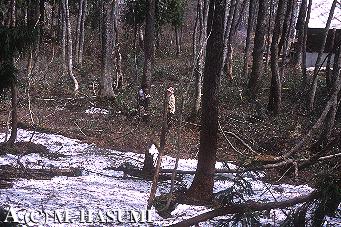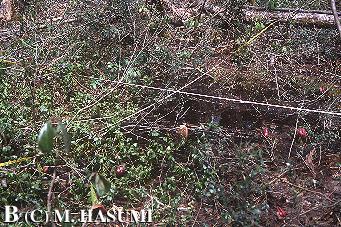

 |
 |
(A) Gross appearance of this wetland. The breeding season of H. hidamontanus this year was delayed by much remaining snow (the lower range of this photograph).
(B) We measured size of an oviposition site (20.0 x 35.1 m area) within the wetland with 30 m- and 50 m-rulers made of glass fibers (lines crossed in the center). Note a relatively large number of Symplocarpus foetidus var. latissimus (purple-red bracts).
Of H. hidamontanus, 7 males with a typical aquatic-phase morph, especially characterized by a congested and swollen cloacal region, 1 gravid female during ovulation, and 3 gravid females after the completion of ovulation were found under decaying logs in the water (water pHs = 5.8-6.3); 2 gravid females in a preovulatory condition, under decaying logs above ground on land (soil pH = 4.6); 2 gravid females after the completion of ovulation (evidence for wandering behavior) and 1 gravid female in a preovulatory condition, under decaying logs near the edge of the water; and 3 pairs of egg sacs, including embryos of the 4-cell stage, under decaying logs in the water. Among those individuals, 2 females possessed rudimentary 5th toes in right and left hindlimbs. There was 1 juvenile of the frog Rana ornativentris in the water.
Accompanied Research Collaborators (alphabetical order): Masaichi Kakegawa (Tokyo Metropolitan Komatsugawa Senior High School), and Fujio Kishi and Yuko Saikawa (Shirouma Association of Naturalists).